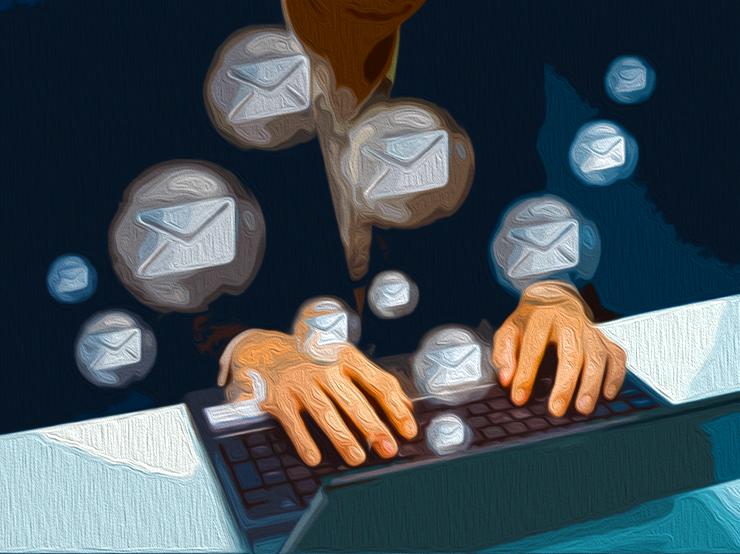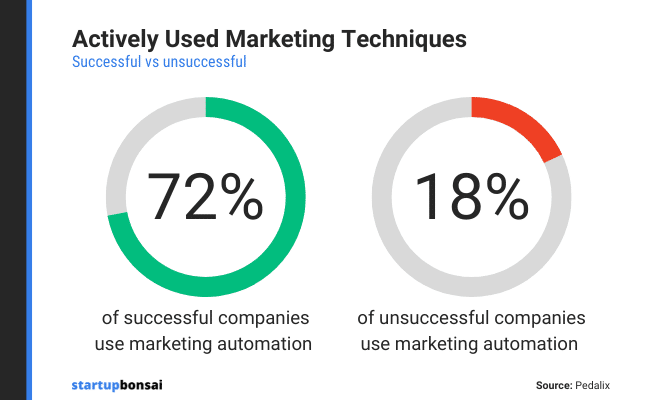
B2B marketing is a hot topic for data-driven marketers. Social Media Today’s "State of Marketing Automation" report revealed that three out of four marketers use automation tools.
Successful Companies Embrace Marketing Automation
Marketing automation is a popular choice among thriving companies. Only 18% of failed companies have fully embraced technology, while 72% of successful ones do.
Benefits of B2B Marketing Automation
B2B Marketing Automation is a powerful tool, but it's not for everyone. How can automation be used to your advantage? MIG has been discussing successful automation for many years and has now written a handbook about it.
Guide to B2B Marketing Automation
Here's a guide to B2B Marketing Automation for maximum results, whether you're new or just need a refresher.
Key Takeaways
Takeaways from the handbook include:
- Automation of repetitive tasks to focus on revenue-generating activities
- Improvement in customer experience, sales and marketing alignment, and lead generation
- Key areas for automation such as live chat, mobile marketing, content targeting, and email campaigns
- Tools like HubSpot, Adobe Marketo, ActiveCampaign, and Salesforce for B2B marketing
- Pre-automation steps like audience research and buyer's path mapping
Understanding B2B Marketing Automation
Software automates repetitive marketing tasks, sending messages to leads as they move through the funnel. Marketing departments use automation for tasks like social media post scheduling and email marketing.

Effectiveness of B2B Marketing Automation
B2B marketing automation helps increase marketing efforts and achieve better results. Omnisend found that marketers using multiple channels saw a 287% increase in purchase rates. SMS marketing and email automation also show significant increases in conversion rates and ROI.
Advantages of B2B Marketing Automation
B2B marketing automation offers several advantages, including improved sales and marketing alignment, increased productivity and efficiency, data-driven strategies, lead generation, higher lead conversions, and better customer understanding.
Successful B2B Marketing Automation Strategies
Examples of successful strategies include live chat, content targeting, mobile marketing, lead scoring, and email marketing campaigns.
Top B2B Marketing Automation Software
Popular B2B marketing automation software includes HubSpot Marketing Hub, Adobe Marketo Engage, ActiveCampaign, Salesforce, and MailChimp, each offering unique features for marketing teams.
Automating Your B2B Marketing
Key steps to automate your B2B marketing include conducting audience research, defining the buyer's journey, identifying strategic placements, and gradually testing and refining automation strategies for optimal results.
Common Pitfalls in Marketing Automation
Businesses may fail at marketing automation due to factors like not including the right people, selecting the wrong vendor, lack of education, and failure to plan for growth. Avoiding these pitfalls can lead to successful automation implementation.

Creating Quality Content for B2B Marketing Automation
Quality content is crucial for successful B2B marketing automation. Content consistency and relevance are key to generating leads and retaining high-value clients. MIG offers services to help businesses create engaging content for their automation strategies.
Conclusion
Marketing automation is a powerful tool when used effectively. By understanding its benefits, implementing successful strategies, and creating quality content, businesses can maximize their marketing efforts and achieve better results in the B2B landscape.
Frequently Asked Questions
What does marketing have to do with business strategy?
Every business strategy must include marketing. Without marketing, no one will know what your company has to offer. Marketing without sales would be pointless. Marketing is essential for any business strategy.
Marketing is important, but not everyone gets it. Marketing is not just about spending money on advertising campaigns. Marketing goes far beyond advertising campaigns. Marketing includes everything you do in order to communicate the company's identity, position and value in the marketplace.
As you consider your business, think of these questions: What image do I want to project? What image will I project to my customers? How should I present myself to the world?
If you don't answer those questions, you haven't thought about marketing yet.
What are the best digital marketing strategies that I can do from home?
Digital marketing is a cost-effective way to reach customers that spend most of their time online. It is also an excellent way to generate leads that will help your business.
To promote your brand, you can use social media platforms such Twitter, Facebook, and LinkedIn. You can also use email marketing tools to send emails to potential clients and prospects.
There are many other ways you can market your product or service using digital mediums.
These channels can be used effectively if you have the right knowledge.
What are the primary types of marketing you use?
Marketing is the act of communicating ideas, values, and messages to consumers. It is common to hear “marketing” interchangeably used with advertising. Marketing encompasses more than advertising. Marketing encompasses all forms of communication used to promote and market a product/service.
Three key components of marketing are branding, promotion and distribution. Branding refers to how a company identifies itself to its target audience. Promotion is the act or obtaining attention for your brand using paid advertisements, promotional materials, and public relations. Distribution is how you get your message across to your target audience. You can do it through traditional media like radio, television, print, or email. However, new technologies make this easier than ever.
What makes it so important to identify your brand?
A brand is simply the promise your company makes to its clients. Your brand is a promise that your company will deliver certain benefits and qualities that will make you stand out from the rest. Your brand is what differentiates you from others in the same industry.
Your brand will give you authority and credibility. Potential customers instantly recognize your company's logo when they see it. They trust your company because you have earned their respect.
Your company's culture is also part of your brand. If your employees feel passionate about your brand, it probably reflects your passion for your product or service.
Your brand is much more than words and pictures. It's a promise that you company will keep. It's a promise to provide value to your customers.
When you set out to develop your brand, you need to consider several factors. First, you need to choose a name which clearly describes the company's mission. Sweet Dreams Bakery is a good example of a bakery name. If you run a software business, however, you would probably choose DreamSpark Software.
Next, consider how your brand will be presented. Are you going to use a familiar symbol? Will you use colors that complement your corporate image? Will you use logos
You must also think about the perceptions of your target market regarding your brand. Do you present yourself as helpful and friendly? Are you trustworthy and professional? Will you be able to demonstrate your expertise and knowledge?
These are all important questions you should ask before building your brand.
What are three examples of internet marketing strategies?
Internet Marketing can be described as a broad term that covers online activities to promote products and/or services. Internet marketing covers email marketing as well social media marketing, search engine optimiz (SEO), PPC advertising (PPC), web design and other related activities.
These terms don't necessarily mean that you have to spend money in order to make money. There are plenty of ways to generate income without spending any cash whatsoever. The better the return on your investment in each method, however, is the greater the potential for income.
Email marketing is perhaps the most well-known form of online marketing. This involves sending emails to potential customers informing them about your company and the latest offers.
Social Media Marketing is another popular way to advertise. Users can share information with their friends and family on social media sites like Facebook, Twitter, or LinkedIn. Businesses also have the opportunity to reach out to their customers and raise awareness about their products and services through these sites.
Search Engine Optimization is a technique for increasing the visibility and popularity of websites on major search engines. By improving the quality and quantity of relevant backlinks, webmasters can boost traffic to their sites.
Website design is the art of creating a website that is attractive and functional. Website designers create the website's layout and style. Website designers also ensure accessibility standards are met and that technical specifications are adhered to.
Advertisers can bid on keywords that are related to their products and services through Pay Per Click Advertising (PPC). Advertisers pay when someone clicks on their ad. PPC ads typically appear at the bottom or top of search result pages.
Social Media Marketing offers a great opportunity to promote your business online. It's a great way to build brand awareness and generate leads. Here are five ways to use social media marketing to boost your business.
- Create a Facebook Fanpage – This allows customers to interact directly via Facebook. You can upload photos, videos and other files.
- Promote Your Business on Twitter – Twitter is another great place to share information and connect with people. Increase visibility by using hashtags
- Upload videos to YouTube – People love watching videos. If they like what they see they might click to visit your site.
- Host Live Event – Hosting live events will allow you to meet face to face with potential clients. They will be able to ask questions about the products and services you offer.
- Respond to Customer Reviews. Positive reviews can build trust with clients and encourage repeat sales. Respond quickly to any negative comments.
Statistics
- This allows us to deliver CPCs that are 80% less than average and CTRs 4-5 times higher than average. (marketinginsidergroup.com)
- A poll earlier this year found that 14% of older Gen Z's had bought an item in the previous six months based on an influencer's recommendation. (influencermarketinghub.com)
- Companies that use personalization are seeing revenue increases ranging from 6-10%. (blog.hubspot.com)
- According to statistics, 60% of online shoppers worldwide actively search for coupons before purchasing from a virtual shop. (influencermarketinghub.com)
- 81% of brands employ affiliate marketing, and eCommerce sites are particularly good candidates. (blog.hubspot.com)
External Links
statista.com
neilpatel.com
- How to Use Search Engine Optimization to Build Your Brand
- Marketing Automation: What is it, Examples & Tools [2022]
youtube.com
influencermarketinghub.com
How To
You must ensure that your content is relevant to your audience when you create content for online marketing. If your audience isn't interested in your product, then why should they care about the content you create for online marketing?
For example, if your website is about fashion accessories, make sure your content is related to fashion accessories. Not general web design tips.
Social media platforms like Facebook and Twitter can be a powerful way to promote your company. Businesses can use social media platforms to communicate with customers and share information.
It's also a great way to get in touch with clients, both current and potential.
Content that encourages sharing with friends and engages users is a good idea. Shared content often reaches more people and increases traffic to your site.
You can keep your content fresh and updated by posting regular updates. Posting once a month or more is better than posting daily.
Posted content receives more attention because readers expect to see new material.
In your content, include links that point back to your homepage. This makes it easy for visitors to locate additional resources on the site.
Mobile-friendly content is a must. Mobile devices now outnumber desktop computers. According to a recent survey more than half of internet users access websites via smartphones.
To ensure that your content is well-viewed on smaller screens, test it on different smartphone and tablet browsers. The mobile-first approach is a must-have for website developers and owners.
It's about more than just aesthetics. Mobile sites are more likely to convert better than desktop websites. Not only are they easier to navigate, but they also tend to load faster because of the smaller size of the site.
You should create content that is meaningful to your audience.
————————————————————————————————————————————–
By: 6938
Title: B2B Marketing Automation Handbook
Sourced From: internetlib.org/b2b-marketing-automation-handbook/
Published Date: 7/5/2023 6:39:24 PM
